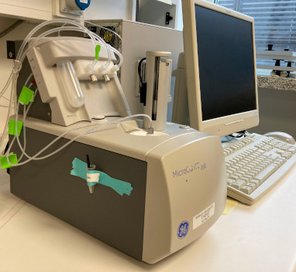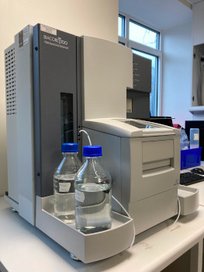

Isothermal titration calorimetry (ITC).
Isothermal calorimetry quantifies binding affinity (Kd), stoichiometry as well as thermodynamic parameters such as enthalpy and entropy. ITC is especially good for measuring binding of small molecules to biomolecules. The downside of ITC is that it can be rather demanding in terms of material. We have two ITC instruments:
Microcal iTC200
The ITC200 is currently our most modern and user-friendly ITC instrument. It has a small cell volume, and thus use less material than the VP-ITC but requires samples to be at slightly higher concentration.
VP-ITC
The VP-ITC has a larger cell volume, which allow it to be used for samples where the solubility is a problem.
Surface plasmon resonance (SPR)
Biacore T100
Surface plasmon resonance measures the binding and dissociation rates of biomolecules attached to a chip, which allows determination of the affinity. Unlike our other instruments for measuring interactions, SPR also determines the rate constants (kinetics). SPR works best for interactions between macromolecules and only in some cases for small molecules. This instrument is administrated by Christine Schar (cschar@mbg.au.dk).
Microscale Thermophoresis (MST)
Nanotemper NT.115
MST measures the migration of fluorescently labelled molecules in a thermal gradient. The migration changes upon ligand binding, which allows the affinity to be determined by titrating in the ligand. MST requires one component of the interaction to be fluorescently labelled. MST works in the present of detergents, and is thus suited for many membrane proteins.
Fluorescence
For some systems it might be possible to follow a titration using fluorescence titration using some of the instruments below. The Nanotemper Panta can follow a titration based on the spectral shift of the tryptophan fluorescence. This works best when there is a tryptophan residue near the binding site. The multimode plater reader has a fluorescence polarization module. This works well for smaller molecules that can be easily fluorescently labelled, e.g., peptide.
Differential scanning fluorimetry(DSF)/Dynamic light scattering (DLS)
Nanotemper Prometheus Panta
The Panta is a state-of-the-art instrument for nanoscale differential scanning fluorescence (DSF) and dynamic light scattering (DLS). Thermal stability is measured via the spectral shift of tryptophan following protein unfolding, which reports a melting temperature. The Panta measures 48 samples in parallel and is thus well suited for moderate through-put screening. Typical applications include formulation of proteins in stable conditions, comparison of mutants or screening for ligands. The DLS module measures the size and homogeneity of particles either at a static temperature or during the thermal unfolding.
Complex assembly and size
Refeyn MPTwo
The mass photometry instrument from Refeyn measures the sizes of particles in solution. Because mass photometry works at the single molecule level, it is ideal for deconvoluting heterogeneous mixtures of complexes. The lower detection limit is at 30 kDa and samples concentrations should be around 10 nM.
Functional assays
Liquid scintillation counter
Perkin-Elmer Tri-Carb 4910 TR
The liquid scintillation counter measures radioactivity from a range of isotopes used in biochemical assays such as 3H and 32P. Work with radioactive isotopes must comply with local safety regulations.
Multimode platereader
Molecular Devices SpectraMax i3
The multimode-platereader measures a range of optical signals used in biochemical assays including absorption, luminescence, fluorescence, FRET, and fluorescence polarization. The plate reader format is well suited for high-through put experiments.
UV-Vis spectrophotometer
PerkinElmer Lambda 25
The UV-VIS spectrophotometer is cuvette-based instrument for measuring absorption and turbidity.